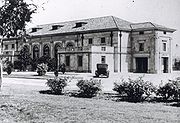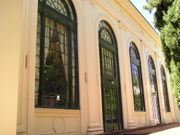
Albert Hall, Canberra
Encyclopedia


Canberra
Canberra is the capital city of Australia. With a population of over 345,000, it is Australia's largest inland city and the eighth-largest city overall. The city is located at the northern end of the Australian Capital Territory , south-west of Sydney, and north-east of Melbourne...
, Australia, used for entertainment. It is on Commonwealth Avenue
Commonwealth Avenue, Canberra
Commonwealth Avenue is a major road in Canberra, Australian Capital Territory, Australia. It connects Civic with South Canberra. Specifically, it runs between City Hill and Capital Hill....
between Commonwealth Bridge and the Hotel Canberra
Hotel Canberra
The Hotel Canberra, also known as Hyatt Hotel Canberra is in Yarralumla, near Lake Burley Griffin and Parliament House, in Canberra. It was built to house politicians when the Federal Parliament moved to Canberra. It was constructed by the contractor John Howie between 1922-1925. Originally...
in the suburb of Yarralumla
Yarralumla, Australian Capital Territory
Yarralumla is a large inner south suburb of Canberra, the capital city of Australia. Located approximately south-west of the city, Yarralumla extends along the south-west bank of Lake Burley Griffin...
.
Overview
The hall was opened on 10 March 1928 by the Prime Minister, Stanley BruceStanley Bruce
Stanley Melbourne Bruce, 1st Viscount Bruce of Melbourne, CH, MC, FRS, PC , was an Australian politician and diplomat, and the eighth Prime Minister of Australia. He was the second Australian granted an hereditary peerage of the United Kingdom, but the first whose peerage was formally created...
. Bruce named the hall, explaining at the opening ceremony that he had chosen the name from the Royal Albert Hall
Royal Albert Hall
The Royal Albert Hall is a concert hall situated on the northern edge of the South Kensington area, in the City of Westminster, London, England, best known for holding the annual summer Proms concerts since 1941....
in London and also because it was the first name of the Duke of York, later King George VI
George VI of the United Kingdom
George VI was King of the United Kingdom and the Dominions of the British Commonwealth from 11 December 1936 until his death...
and furthermore that it commemorated the "Consort of the Queen
Victoria of the United Kingdom
Victoria was the monarch of the United Kingdom of Great Britain and Ireland from 20 June 1837 until her death. From 1 May 1876, she used the additional title of Empress of India....
who had proclaimed the Australian Commonwealth
Federation of Australia
The Federation of Australia was the process by which the six separate British self-governing colonies of New South Wales, Queensland, South Australia, Tasmania, Victoria and Western Australia formed one nation...
".
The hall was designed by the Federal Capital Commission
Federal Capital Commission
The Federal Capital Commission was an agency of the Australian government formed to construct and administer Canberra from 1 January 1925. The Chief Commissioner of the body was Sir John Butters....
architect John Kirkpatrick, assisted by Robert Casboulte and Henry Rolland. It is in the Georgian
Georgian architecture
Georgian architecture is the name given in most English-speaking countries to the set of architectural styles current between 1720 and 1840. It is eponymous for the first four British monarchs of the House of Hanover—George I of Great Britain, George II of Great Britain, George III of the United...
Revival style. A porte-cochere
Porte-cochere
A porte-cochère is the architectural term for a porch- or portico-like structure at a main or secondary entrance to a building through which a horse and carriage can pass in order for the occupants to alight under cover, protected from the weather.The porte-cochère was a feature of many late 18th...
at the front allows for passengers from vehicles to alight undercover. The hall was not heated in its early years, and patrons had to bring rugs, thick coats and water bottles. Singers were known to perform in fur coats until heating was finally installed after World War II.
Prior to its construction, the largest hall in the Federal Capital Territory
Australian Capital Territory
The Australian Capital Territory, often abbreviated ACT, is the capital territory of the Commonwealth of Australia and is the smallest self-governing internal territory...
was at the Causeway in Kingston
Kingston, Australian Capital Territory
Kingston is the oldest and most densely populated suburb of Canberra, Australian Capital Territory, Australia. The suburb is named after Charles Cameron Kingston, the former Premier of South Australia and minister in the first Australian Commonwealth Government. It is adjacent to the suburbs of...
. Until the completion of the Canberra Theatre
Canberra Theatre
The Canberra Theatre Centre is the Australian Capital Territory’s central performing arts venue and Australia’s first performing arts centre, the first Australian Government initiated performing arts centre to be completed, that opened on Thursday 24 June 1965 with a gala performance by the...
in 1965, the Albert Hall was the only place in Canberra for audiences of more than 700 people other than the picture theatres.
The Albert Hall is used by a range of groups, individuals and commercial operators. It is used on weekends and during the week for private events, dances, balls, performances, cultural activities and commercial sales.
Compton Theatre Organ
The Compton Theatre OrganTheatre organ
A theatre organ is a pipe organ originally designed specifically for imitation of an orchestra. New designs have tended to be around some of the sounds and blends unique to the instrument itself....
was installed in Albert Hall in the late 1980s, after the ACT Division of the Theatre Organ Society of Australia took delivery of its components and spent almost ten years restoring the organ. Its inaugural concert was on 17 August 1986, with organist Tony Fenelon. This organ had originally been, from March 1933 until 1968, in the Gaumont Palace (later re-named the Odeon Theatre) in Cheltenham, Gloucestershire
Gloucestershire
Gloucestershire is a county in South West England. The county comprises part of the Cotswold Hills, part of the flat fertile valley of the River Severn, and the entire Forest of Dean....
, UK. An almost identical Compton organ, also installed in 1933 at Worthing
Worthing
Worthing is a large seaside town with borough status in West Sussex, within the historic County of Sussex, forming part of the Brighton/Worthing/Littlehampton conurbation. It is situated at the foot of the South Downs, west of Brighton, and east of the county town of Chichester...
, West Sussex
West Sussex
West Sussex is a county in the south of England, bordering onto East Sussex , Hampshire and Surrey. The county of Sussex has been divided into East and West since the 12th century, and obtained separate county councils in 1888, but it remained a single ceremonial county until 1974 and the coming...
, was also re-established in 1986, in Nedlands, Western Australia
Nedlands, Western Australia
The City of Nedlands is a Local Government Area in the inner western suburbs of the Western Australian capital city of Perth, located about west of Perth's central business district...
; a more comprehensive 1937 Compton is in Ballarat, Victoria
Ballarat, Victoria
Ballarat is a city in the state of Victoria, Australia, approximately west-north-west of the state capital Melbourne situated on the lower plains of the Great Dividing Range and the Yarrowee River catchment. It is the largest inland centre and third most populous city in the state and the fifth...
.
Heritage and Development Controversy
On 22 February 2007, the National Capital AuthorityNational Capital Authority
The National Capital Authority is a body of the Australian Government that was established to manage the Commonwealth's interest in the planning and development of Canberra as the capital city of Australia....
(NCA) released National Capital Draft Amendment 53 - Albert Hall Precinct. This amendment to the development plans for the city was intended to reinstate some of the plans that were originally made by Walter Burley Griffin
Walter Burley Griffin
Walter Burley Griffin was an American architect and landscape architect, who is best known for his role in designing Canberra, Australia's capital city...
when he designed the city in 1912, which had been neglected in the years following Griffin's departure from Canberra, when the Albert Hall was constructed. The plan intended to reinforce the geometry, landscape and purpose of the area surrounding the Albert Hall, including Commonwealth Avenue
Commonwealth Avenue, Canberra
Commonwealth Avenue is a major road in Canberra, Australian Capital Territory, Australia. It connects Civic with South Canberra. Specifically, it runs between City Hill and Capital Hill....
in front of the hall, and the open space facing Lake Burley Griffin
Lake Burley Griffin
Lake Burley Griffin is an artificial lake in the centre of Canberra, the capital of Australia. It was completed in 1963 after the Molonglo River—which ran between the city centre and Parliamentary Triangle—was dammed...
at its rear. In particular, the amendment suggested that the land around the Albert Hall would be opened up for commercial purposes such as cafes and tourist facilities. The amendment also made reference to a 'landmark building' north of Albert Hall, which would presumably house these facilities.
There was a lot of discussion about the plans outlined in the amendment. An action group formed to oppose the plan, under the emotive catch-cry of "Save Albert Hall". Ongoing public debate and anger directed towards the authorities involved led to the National Capital Authority holding public meetings on 5 March, and later added more meetings on 22 and 24 March. Finally, at a meeting on 2 April 2007, it was agreed that the NCA would not proceed with the landmark building, and that the land would be used as a "public lakeside park". The organisation continues to campaign to protect the Albert Hall and its precinct. The building, which was previously listed only on the Heritage Places register, has been suggested for inclusion on the National Heritage List, which would make it extremely difficult for government authorities to make further attempts to develop the precinct. In the lead-up to the 2007 Federal Election, the Labor
Australian Labor Party
The Australian Labor Party is an Australian political party. It has been the governing party of the Commonwealth of Australia since the 2007 federal election. Julia Gillard is the party's federal parliamentary leader and Prime Minister of Australia...
Senator Kate Lundy
Kate Lundy
Kate Alexandra Lundy is a member of the Australian Senate, representing the Australian Capital Territory.Born in Sydney, Lundy dropped out of Year 11 without telling her parents and went to work on a construction site...
committed $500,000 to the restoration of the Albert Hall.

